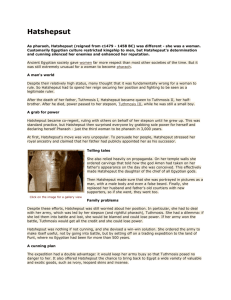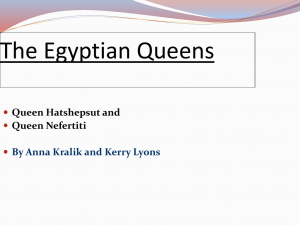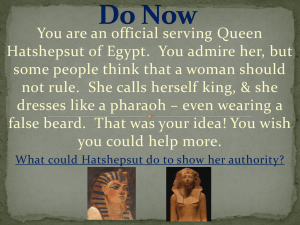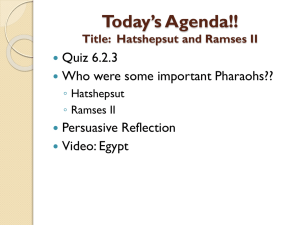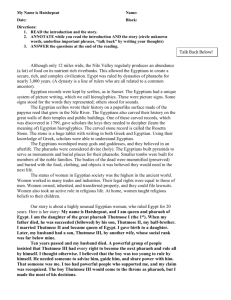Religious Innovations of Hatshepsut
advertisement
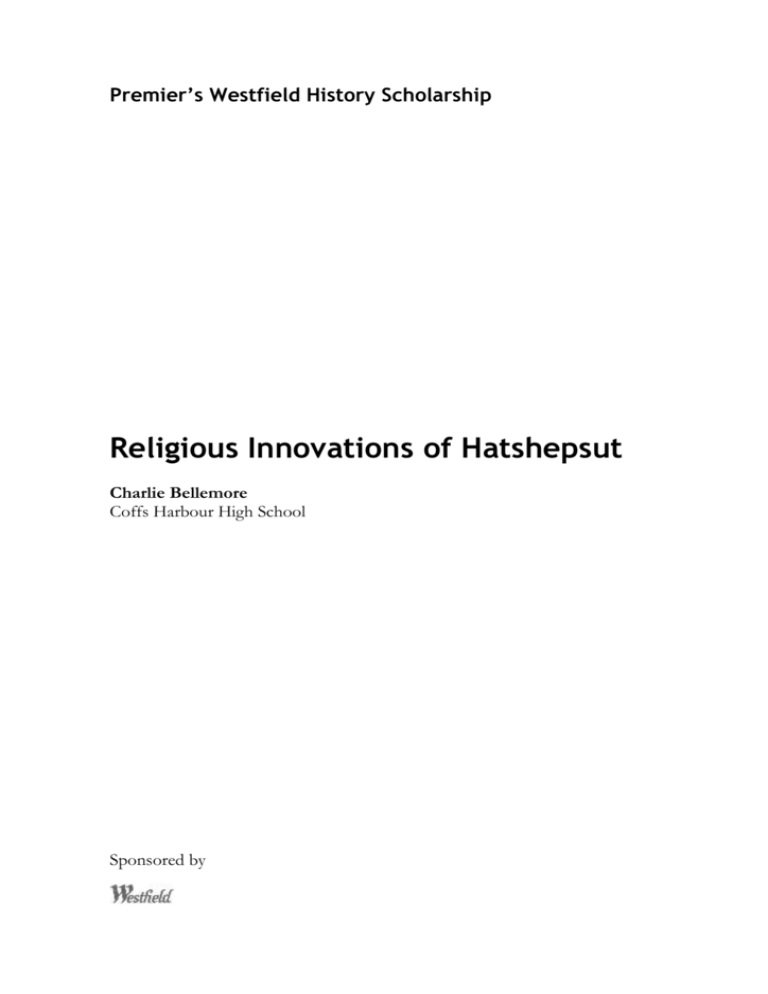
Premier’s Westfield History Scholarship Religious Innovations of Hatshepsut Charlie Bellemore Coffs Harbour High School Sponsored by PREMIER’S TEACHER SCHOLARSHIP REPORTS, PART 1/2 The Focus of the Study The purpose of my study tour was to search for new research and views on the religious innovations of Hatshepsut’s rule in New Kingdom Egypt. The trip encompassed visits to the USA, the United Kingdom and Egypt. Although I visited sites including the Cairo Museum, British Museum, Karnak Temple and the Red Chapel, I selected only a few of the sites visited for this paper. Kimbrell Art Museum, Fort Worth Texas The first stop was the Kimbrell Art Museum in Fort Worth Texas. I spent two days viewing the exhibits and taking notes of over 250 exhibits related to Hatshepsut. It was here that the influence of Senenmut the most prominent official in Hatshepsut’s rule became apparent by the number and variety of his statues on display. There were unique pieces of Senenmut and Neferure (Hatshepsut’s daughter) which were never replicated as an art style again were on display. The inscriptional evidence sets Senenmut apart from the other officials of Hatshepsut’s time. One example reads: I am a dignitary, beloved of his lord, who has entrée to the wonderful Character of the mistress of the two lands (Hatshepsut). He (Hatshepsut) has ennobled me before the Two Lands and made me chief spokesman of his Estate, and judge in the entire land, inasmuch as I was efficient in his opinion in that I nurtured the eldest princess (King’s Daughter), the God’s Wife, Neferure, alive. I was given to her as Goddesses’ father because of my effectiveness on behalf of the King. (Keller, C. In Roehrig 2005:116) There are 25 Senenmut statues so far uncovered and the themes vary showing Senenmut with Neferure (7) in block statue form and one of Senenmut alone; seated statues of Senenmut (4); kneeling with a sistrum(4); kneeling with votive offerings (4) kneeling with cryptogram (a secret message) (3) and finally, a statue of Senenmut holding a field surveyor’s chord which was later copied by later officials who oversaw the granary of Amun at Karnak Temple. This was an innovation during Hatshepsut’s time. The importance of the Hathor cult and the promotion of the cult during Hatshepsut’s rule were evident by the variety and widespread distribution of votive offerings to Hathor in Egypt. Hathor was the goddess of fertility and nature and she had a role as a sky goddess. In the exhibition, there were over 20 pieces dedicated to Hathor. Unlike the large temples which were largely inaccessible except to the king, Hathor shrines were places where anyone could make a dedication. Her popularity during this time can be assessed by the volume of finds and the quality of manufacture. Votive offerings to Hathor include stelae, figurines, objects, vessels, amulets and jewellery as well as textiles, models of Hathor masks, figures of cows and cats. PREMIER’S TEACHER SCHOLARSHIP REPORTS, PART 1/2 Connected with the Hathor cult were the presence of beautiful blue wash faience Marsh Bowls which symbolised fertility, regeneration and rebirth. They were perceived to be potent gifts for the dead to assist in their rebirth. The blue colour of the bowls is tied to Hathor the “Lady of Turquoise” and Hathor Goddess of the Wet where the dead are reborn. The exhibition contained some magnificent examples of stylised faience bowls with lotus and fish themes. Hatshepsut maintained religious traditions and one of her claims she made that she restored temples destroyed from the Hyksos period. Also, she constructed temples and although her reverence towards the god Amun is well documented, other gods were revered. A good example is the Temple to the goddess Anukis built on Elephantine Island Aswan where Anukis is associated with Aswan and exotic goods imported from the south into Egypt. The exhibit of Anukis is a wonderful example of the artistic period of the late co-regency. The connection to the Voyage to Punt Scene at Deir el Bahri temple is a powerful reminder of the importance of international trade maintained during Hatshepsut’s time. New York Metropolitan Museum One of the highlights was my time spent with Dr Catharine Roehrig, Curator of Egyptian Art at the New York Metropolitan Museum of Art. I spent five hours with her discussing Hatshepsut’s rule and reflected on some of her religious innovations. Hatshepsut, according to Roehrig, used a myth to indicate she was the chosen one through the use of an oracle. There is no evidence of oracles from earlier kings but there is much evidence of kings who used oracles to justify some aspect of their rule after her time. She was the first to use the myth that she was the bodily image of the child of Amun but the king has always been the bodily form of Re. Amenhotep III has the same imagery in his temple at Luxor. Roehrig suggests Hatshepsut copied something her father may have done as he was not the son of the previous king and he may have had to do a few things to legitimise his reign. It may have been possible that he did this or she may have been the first to do so, either of which is perfectly possible. Hatshepsut did copy a number of things such as the Amduat in her burial chamber. However, she was the first king to put it in her burial chamber. This tradition was then copied by succeeding pharaohs in their burial chambers. She saw the devotion towards the Amun cult had an economic influence as it put people back to work and allowed the creation of a state god temple for the Egyptian people. As for the restoration of temples and worship of other gods, she believed it was an integral part of being Egyptian. It was Hatshepsut’s duty to do this. The discussion then centred on the warrior pharaoh images of Hatshepsut which were obviously male but on the back of each of the statues are prenames and personal names of Hatshepsut and Maatkare. Hatshepsut never denied she was female. There was always something on the statues indicating she was female.Nor was she trying to pass herself off as a male. Often in inscriptions she has inscribed the feminine beloved of Re not the masculine beloved of Re. It’s not that the inscribers were confused, but rather they wanted to ensure that her femininity was mentioned. For example, there is a statue of her sitting on a throne with the right side on the back of the statue having inscriptions in masculine form and on the left side they are in the feminine form. The Egyptians were not confused about Hatshepsut being a woman as they have known her as Thutmosis I’s daughter and then the great wife of a pharaoh and then as a Pharaoh in her own right. My interview moved to Deir el Bahri and I indicated that was a place of spiritual significance to the Egyptians and Roehrig confirmed it was used as a burial place for at PREMIER’S TEACHER SCHOLARSHIP REPORTS, PART 1/2 least a 1000 years prior to the temple being constructed and their tombs built over tombs but she added really the Qurn which means “the horn” in Arabic which is the high place in the necropolis was important. It is a naturally formed pyramid shaped hill top which had spiritual significance. I suggested that Hatshepsut’s temple aligned with Karnak but she disagreed saying it aligns itself with the Temple of Mut (Amun’s consort). Luxor Museum The quality of the artefacts at this site is essential for an understanding of Hatshepsut’s rule and New Kingdom Egypt. One of the fascinating pieces was a door jamb of Anincense which was a part of a treasury of Incense. The inscription on the black diorite block relates to Hatshepsut whereby the inscription relates Hatshepsut: has done as her memorial for her father Amun Re for the preparation of the daily incense pellets, so that this House of Amun might be filled with the fragrance of the god’s land. If one relates this adoration of Amun to the Voyage to Punt Relief at Deir el Bahri Temple, the importance of the expedition’s goods being devoted to the cult of Amun becomes clearer and the significance The State god Amun Re as the most important of the gods worshipped at Thebes during the Early New Kingdom period. However, representations of Amun connect him with other gods such as Min a fertility god. An example of this was shown in a stunning relief in limestone found at Deir el Bahri which was later destroyed during the Amarna period. There were many other exhibits related to Hatshepsut including a small porphyry statuette of Senenmut with a Hatshepsut cartouche; a statue of Hatshepsut depicted as a woman standing in the presence of Amun; and a rare wall fragment showing Thutmosis II (her husband) and Queen Hatshepsut as royal consort wearing a long dress and holding a sceptre inscribed as sceptre of the good wives found at Karnak Temple. Luxor Temple The religious innovations established at Luxor Temple by Hatshepsut were maintained as a tradition through to Ptolemaic times at this site (Bell 1997:147-148). Evidence for the presence of Hatshepsut and Thutmosis III constructing the Tripartite Shrine to Amun, Mut and Khonsu can be viewed from the reuse of sandstone drums from polygonal columns by Amenhotep III re-used in walls from the Vestibule Offering southward. Also, the Triple Shrine rebuilt by Ramsesses II used materials from Hatshepsut’s rule. It was here that the portable image of Amun Re resided when he visited the Luxor Temple for the Opet Festival. This festival was the longest in the Theban calendar which grew from eleven days to twenty four days (Bell 1997:158). This tradition was established by Hatshepsut and the connection of Luxor Temple in the festival was one of a public procession of the king from Karnak to here, his fateful meeting with his divine father Amun Re and his procession back to Karnak. Hatshepsut’s Mortuary Temple Deir El Bahri Luxor The Mortuary Temple at Deir el Bahri is a remarkable restoration. Dr Ray Johnson described the Upper Terrace of the Temple as the best representation of Eighteenth Dynasty Karnak around Hatshepsut’s time. The temple is not so much an innovation of religious worship but some of its design features were quite unique. Karkowski (2003:69) believes the Solar Complex in the Upper Terrace is the earliest New Kingdom example of a series of similar complexes in mortuary temples at Thebes. The high court walls PREMIER’S TEACHER SCHOLARSHIP REPORTS, PART 1/2 screen the movement of the sun as the Solar Complex formed a model of the Universe for the crucial phases of the solar journey in which the king played the role of a solar god and became a participant with the sun god when he died. Representations of Hatshepsut occur on five occasions in the complex with one representation of Thutmosis III. Hatshepsut is the dominant king represented in the complex. Although Amun is the dominant deity of the Solar Complex, many other gods are present in scenes such as Thoth, Atum, Re-Horakhty, Ptah, Sokaris and Osiris. The opportunity to visit the Solar Complex gave a clear perspective of how Hatshepsut identified herself with Amun Re and images of her present inside niches where statues of Amun resided support this connection. Amun is referred to as the Lord of Karnak and this complex stresses the role of Thebes as the seat of the supreme god of the country (Karkowski 2003:56). I visited the Hatshepsut Chapel on the southern side of the Upper Terrace which is currently being restored by the Egyptian Polish Archaeological team. The project will take five years to restore and the dominant features of the chapel show offering reliefs to the god Amun Re. I interviewed one team member, Yaga, who took me on a tour of their work and I was amazed at the condition of the reliefs in terms of colour and mostly undamaged stones despite the presence of Coptic Christians in the Middle Ages who chiselled out images of Hatshepsut here. She indicated that the religious innovations of the Festival of Opet (Eastern Wall) and the Beautiful Festival of the Valley (Northern Wall) appear prominently in the Upper Terrace. She indicated that the name of Neferure (her daughter) had been removed outside the Amun Re complex. Whether the presence of her name indicated her potential succession is speculative as there is little other evidence. Osiride statues of Hatshepsut Upper Terrace Deir el Bahri Temple of Mut Luxor The Temple of Mut at Luxor has been overlooked as a site for an important religious innovation during Hatshepsut’s rule. John Hopkins University is currently excavating and restoring the site. Mut had her own temple in the southern precinct of Karnak, and the main temple was linked to it by two different paved alleys flanked by rows of ram headed sphinxes. The god Amun's statue was brought to the Mut temple when rituals occurred commemorating the birth of a son to Amun and Mut. That son, Khonsu, a moon god, has his own temple at Karnak as well. For six years JHU has worked behind the Sacred Lake of the precinct. Thus far the excavation has identified production areas of the Eighteenth Dynasty (ca. 1479-1300 BC), including industrial and food processing PREMIER’S TEACHER SCHOLARSHIP REPORTS, PART 1/2 installations. Granaries and bakeries of the Eighteenth Dynasty and slightly earlier have been identified, as well as New Kingdom enclosure walls and adjacent workshop areas. A second target area for JHU has been inside the temple itself. The New Kingdom temple of Mut, built under Thutmose III and Hatshepsut, will be moved and placed on display in an Open-Air Museum. Remnants of a porch of Hatshepsut dismantled before the sandstone building of the same ruler was found buried beside the Mut Temple and was a living environment ca 1470. BC. Pinkowski (2006:47) believes that Hatshepsut’s accession to the throne provided the opportunity to promote Mut as a powerful goddess. Te Velde (1977:461) supports the idea that Mut was the matron of the Theban Triad and she was present at the festivals of Opet and the Beautiful Festival of the Valley and he believes that from Hatshepsut’s time was represented as a goddess not only wearing the vulture cap but also wearing the royal crowns of Upper and Lower Egypt. University of Chicago, Chicago House,Luxor I was privileged to be able to work at the University of Chicago Library under the directorship of W. Raymond Johnson. The University of Chicago have been working in Luxor for 83 consecutive seasons since 1924 – the longest running archaeological team in Egypt. The Chicago method is to produce large formatted photos and line drawings of sites. Drawings are checked and rechecked for accuracy. Their current work included the sites of Medinet Habu temple and the Colonnade Hall in Luxor Temple. This area contains the imagery of Khonsu barge water procession from the Opet reliefs. It is this restoration which reminded me of the innovations created by Hatshepsut of the Opet Festival which was maintained as a tradition passed down through the dynasties. I interviewed Ray Johnson on the subject of Hatshepsut and the work he and his team were currently undertaking. Part of the interview I completed with Ray was a discussion about the gods of Ancient Egypt and his reflections on the Egyptians’ belief system – worshipping the gods were full of paradoxes. The gods were worshipped according to each city as being like a creator god and a sun god. He believed it was quite remarkable how Amun-Re was able to be the state god in Hatshepsut’s time considering this belief system. He did make an interesting observation about the role of Amun having four different representations in and around Thebes. At Medinet Habu, he was depicted as the unborn one; at Luxor Temple, he is portrayed as part of the birth process; at Karnak Temple he was depicted as the state god and at Deir el Bahri he was associated with mortuary and death rituals. One of the reflections I made about the exhibition of Hatshepsut at the Kimbrell Museum in Fort Worth Texas was the prominence of the Hathor cult in Hatshepsut’s time and he made comment on the fact that there was an important cult centre for Hathor at Dendera and that Hathor was worshipped everywhere in Egypt prior to Hatshepsut’s rule, so she was maintaining a tradition. Hathor was both a consort of Amun as well as the daughter of the god. Hatshepsut restored temples and she set out the basic structures for Luxor and Karnak as well as building temples and, of course, her mortuary temple. Ray summed up the rule of Hatshepsut as the golden age of Egypt in terms of the style of the buildings constructed and the prosperity enjoyed by Egyptians. He saw the relationship between Thutmosis III and Hatshepsut to have been a good one and the temple relief evidence supports this relationship. The Red Chapel is an excellent representation of this relationship. PREMIER’S TEACHER SCHOLARSHIP REPORTS, PART 1/2 I had the opportunity to do research in the library and some of the scholars studied were the archaeological records of Uvo Holscher who did initial research on the Temple of Medinet Habu (1935) which has been an influential work on the restoration of the site by the University of Chicago. Secondly, the excavation work conducted by Henry Winlock (1942) at Deir el Bahri influenced much of the perceptions held of Hatshepsut for the next generation. His finds of the foundation deposits and the dumped Hatshepsut images allowed for significant scholarship on Hatshepsut’s place in New Kingdom Egypt. Medinet Habu Photograph of Dr Ray Johnson outside the restoration work conducted by the University of Chicago on the Temple of Medinet Habu. My site visit to Medinet Habu temple occurred over two days with Dr Ray Johnson. It was here that I saw the importance of Hatshepsut’s religious innovations. The façade to the temple is the only known example in 18th Dynasty Egypt. Ray asserts the building reflected the prosperity of Egypt as well as embodied the style of building innovations initiated by Hatshepsut. The issue of Hatshepsut’s relationship with Thutmosis III was raised and Ray believed the evidence within the temple gives no indication that it was nothing other than a strong one as he emphasised that although Hatshepsut appears over twice as many times in the reliefs, Thutmosis III was still represented. He believes the temple represents the close relationship between the two and he saw the connection more as a motherly approach towards Thutmosis III. The various rooms of the temple gave me an insight into the problems of who defaced Hatshepsut images which appeared in this temple and other sites. Ray cautioned the rather easy connection between Thutmosis III being responsible for the defacements in his bid to reinforce his succession to the throne. He saw that there were three possible candidates for the defacements which include Thutmosis III; Akhenaten as well as the middle Age Coptic Christians in Egypt. It would be very difficult to prove that Thutmosis III was the sole actor in the defacements. His evidence for this was the differences in defacements within the temple. For example, he made the distinction of some Hatshepsut images being cut out quite brutally by Coptic Christians as the image was hacked out deeply indicating that it was meant to kill her. This differs to a defacement of Hatshepsut being changed into an offering table but still the outline of Hatshepsut remains with eyes and mouth of Hatshepsut still can be seen in Room Q of the temple. Again, the inference can be made that she has not been cut out but altered to meet the needs of Thutmosis III and his successors. In Room L of the temple, there are images of Thutmosis III and the god Amun which originally had Hatshepsut alone with the god. Thutmosis III has modified the images to include himself as well as cartouches of Hatshepsut were altered to contain Thutmosis II. It was the layers of work one has to examine before hypothesising about before attributing the actions to Thutmosis III. The temple was started by Hatshepsut and PREMIER’S TEACHER SCHOLARSHIP REPORTS, PART 1/2 continued by Thutmosis III as well as having a Ptolemaic addition. The continuity of religious design and thematic reliefs indicate the significance of Hatshepsut’s religious innovation Evaluation The difficulty of summarising the sites and people interviewed has provided only a brief outline of the religious innovations of Hatshepsut. The importance of her period of rule saw the religious revival of traditional gods worshipped throughout Egypt. Her reestablishment of the cult of Amun and his consorts; the establishment of key festivals, as well as unique religious architecture mark her time as innovative. Bibliography The Chicago House Bulletin, October 2005 to April 2006, The Epigraphic Survey of the Oriental Institute, The University of Chicago, USA, 2006 Holscher, U, The Excavation of Medinet Habu Volume II, The University of Chicago, 1935 John Hopkins University Website Temple of Mut http://www.jhu.edu/neareast/egypttoday2.html Schafer, B E, Temples of Ancient Egypt, Cornell University Press. New York, 1997 Karkowski, J, Deir el Bahri VI Temple of Hatshepsut Solar Complex, Warsaw. Poland Hermann Te Velde, (Ed) Jackie Phillips, Mut and Other Ancient Egyptian Goddesses Ancient Egypt, The Aegean and Near East Volumes I and II, 1977 Pinowski, J,Egypt’s Ageless Goddess in Archaeology, September/October Volume 59, Number 5, 2006 Polish Egyptian Archaeological and Preservation Mission Deir el Bahri, The Temple of Hatshepsut Volume 3, Warsaw Poland, 1973 Roehrig, C. (ed), Hatshepsut: From Queen to Pharaoh, New York Metropolitan Museum of Art, New York, 2005 Shahawy, A., Luxor Museum: The Glory of Ancient Thebes, Farid Atiya Press, Cairo, Egypt, 2005 Winlock, H E, Excavations at Deir el Bahri 1911-1931, Macmillan, New York, 1942
